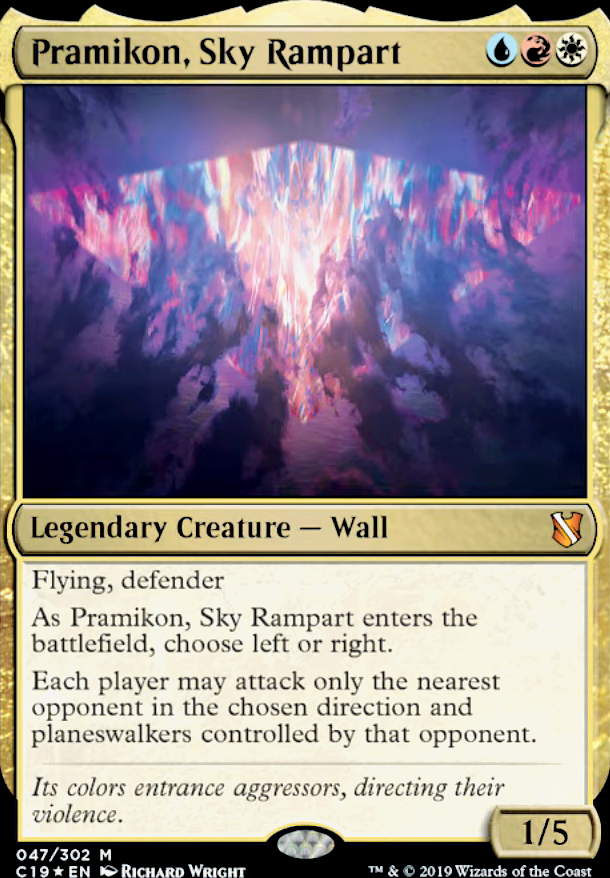
ƒ(x)=Ť̸Ĥ̴€_̷LØ̵Ŕ̶Ë̴Ņ̷Ť̵Ź̶Ị̶Å̶₦_̶M̴Ā̴Ṅ̴Ï̵₣ӪŁ̶Ð̸_̴
Land (36)
- 1x Academy Ruins
- 1x Ancient Den
- 1x Command Beacon
- 1x Command Tower
- 1x Crawling Barrens
- 1x Deserted Beach
- 1x Fiery Islet
- 1x Fomori Vault
- 1x Glacial Fortress
- 1x Great Furnace
-
1x
Hallowed Fountain

- 1x Hengegate Pathway Flip
- 1x Ice Floe
- 1x Inspiring Vantage
- 1x Inventors' Fair
- 1x Maze of Ith
- 1x Meticulous Archive
- 1x Mystic Gate
- 1x Nesting Grounds
- 3x Plains
- 1x Raugrin Triome
- 1x Riverglide Pathway Flip
-
1x
Sacred Foundry

- 1x Sea of Clouds
- 1x Seachrome Coast
- 1x Seat of the Synod
- 1x Spectator Seating
- 1x Sunbaked Canyon
- 1x Sundown Pass
- 1x Thundering Falls
- 1x Tolaria West
- 1x Training Center
- 1x Urza's Saga
- 1x Vivid Creek
Planeswalker (3)
Artifact (33)
-
1x
Astral Cornucopia

- 1x Braided Net Flip
-
1x
Chimeric Egg

- 1x Chromatic Orrery
- 1x Clock of Omens
- 1x Crawlspace
- 1x Dino DNA
-
1x
Dragonspark Reactor

- 1x Empowered Autogenerator
-
1x
Energy Chamber

-
1x
Everflowing Chalice

- 1x Gavel of the Righteous
- 1x Glistening Sphere
- 1x Kayla's Music Box
-
1x
Lux Artillery

-
1x
Lux Cannon

- 1x Manifold Key
- 1x Mazemind Tome
- 1x Midnight Clock
- 1x Moonsilver Key
- 1x Otherworld Atlas
-
1x
Power Conduit

- 1x Shrine of Burning Rage
-
1x
Sol Ring

- 1x Sonic Screwdriver
-
1x
Sun Droplet

-
1x
Surge Node

- 1x The Millennium Calendar
-
1x
Titan Forge

- 1x Tome of Legends
-
1x
Transmogrifying Wand

- 1x Unwinding Clock
-
1x
Vexing Puzzlebox

Enchantment (3)
Commander (1)
Instant (12)
- 1x An Offer You Can't Refuse
-
1x
Clockspinning

- 1x Dawn Charm
- 1x Deflecting Swat
- 1x Dispel
- 1x Experimental Augury
- 1x Fierce Guardianship
- 1x Final Showdown
- 1x Holy Day
- 1x Swan Song
- 1x Teferi's Protection
- 1x Whir of Invention
Creature (11)
- 1x Coretapper
- 1x Deepglow Skate
- 1x Esper Sentinel
- 1x Filigree Sages
- 1x Lost Auramancers
- 1x Mangara, the Diplomat
- 1x Quicksmith Spy
- 1x Scholar of New Horizons
- 1x Spectrum Sentinel
- 1x Spellskite
- 1x Thundersong Trumpeter
Sorcery (3)
Suggestions
Updates Add
Comments
Attention! Complete Comment Tutorial! This annoying message will go away once you do!
Important! Formatting tips — Comment Tutorial — markdown syntax
Please login to comment
93% Casual
Competitive
| Date added | 2 years |
| Last updated | 4 weeks |
| Legality | This deck is not Commander / EDH legal. |
| Rarity (main - side) | 9 - 0 Mythic Rares 57 - 0 Rares 23 - 0 Uncommons 10 - 0 Commons |
| Cards | 102 |
| Avg. CMC | 2.62 |
| Tokens | Bird 2/2 U, Construct 0/0 C, Copy Clone, Golem 9/9 C, Ox 2/4 W, Samurai 2/2 W w/ Double strike, Treasure, Wall 0/4 W |
| Votes | |
| Ignored suggestions | |
| Shared with | |
| Views |
